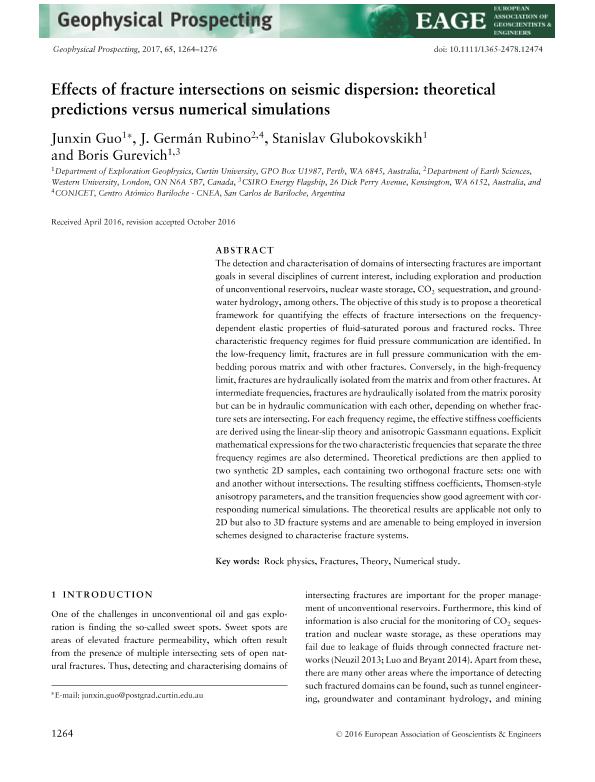Artículo
Effects of fracture intersections on seismic dispersion: theoretical predictions versus numerical simulations
Fecha de publicación:
09/2017
Editorial:
Wiley Blackwell Publishing, Inc
Revista:
Geophysical Prospecting
ISSN:
0016-8025
Idioma:
Inglés
Tipo de recurso:
Artículo publicado
Clasificación temática:
Resumen
The detection and characterisation of domains of intersecting fractures are important goals in several disciplines of current interest, including exploration and production of unconventional reservoirs, nuclear waste storage, CO2 sequestration, and groundwater hydrology, among others. The objective of this study is to propose a theoretical framework for quantifying the effects of fracture intersections on the frequency-dependent elastic properties of fluid-saturated porous and fractured rocks. Three characteristic frequency regimes for fluid pressure communication are identified. In the low-frequency limit, fractures are in full pressure communication with the embedding porous matrix and with other fractures. Conversely, in the high-frequency limit, fractures are hydraulically isolated from the matrix and from other fractures. At intermediate frequencies, fractures are hydraulically isolated from the matrix porosity but can be in hydraulic communication with each other, depending on whether fracture sets are intersecting. For each frequency regime, the effective stiffness coefficients are derived using the linear-slip theory and anisotropic Gassmann equations. Explicit mathematical expressions for the two characteristic frequencies that separate the three frequency regimes are also determined. Theoretical predictions are then applied to two synthetic 2D samples, each containing two orthogonal fracture sets: one with and another without intersections. The resulting stiffness coefficients, Thomsen-style anisotropy parameters, and the transition frequencies show good agreement with corresponding numerical simulations. The theoretical results are applicable not only to 2D but also to 3D fracture systems and are amenable to being employed in inversion schemes designed to characterise fracture systems.
Palabras clave:
Fractures
,
Numerical Study
,
Rock Physics
,
Theory
Archivos asociados
Licencia
Identificadores
Colecciones
Articulos(CCT - PATAGONIA NORTE)
Articulos de CTRO.CIENTIFICO TECNOL.CONICET - PATAGONIA NORTE
Articulos de CTRO.CIENTIFICO TECNOL.CONICET - PATAGONIA NORTE
Citación
Guo, Junxin; Rubino, Jorge German; Glubokovskikh, Stanislav; Gurevich, Boris; Effects of fracture intersections on seismic dispersion: theoretical predictions versus numerical simulations; Wiley Blackwell Publishing, Inc; Geophysical Prospecting; 65; 5; 9-2017; 1264-1276
Compartir
Altmétricas




